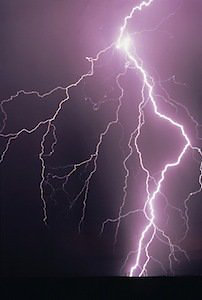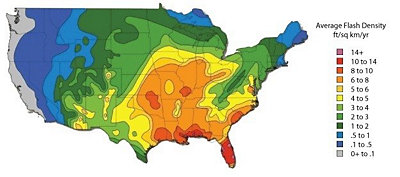Surge Protector vs. Circuit Breaker: What’s the Difference?
December 09, 2015
You understand that both surge protectors and circuit breakers protect “electrical stuff” in your home. But what does one do that the other does not?
Here’s a summary:
- Circuit breakers keep wires from starting a fire. Circuit breakers are necessary.
- Surge protectors protect electrical appliances from voltage spikes. Surge protectors are optional, but highly recommended in Florida due to high number of lightning strikes in the area per year.
Let’s explain the differences in more detail.
Circuit breakers keep wires from catching on fire
Circuit breakers have one job: Prevent the wiring inside your house from starting a fire.
When would this happen? When there’s too much electrical current (amps) flowing through the wires, causing them to overheat and start a fire. Wires are rated to handle a certain amount of electrical current.
For example, when a 15-amp circuit has 20 amps flowing through it, eventually the circuit breaker will ‘trip’ (cut off the flow of electricity). Tripping the breaker prevents wires from overheating and igniting wire’s insulation.
Think of an electrical overload like attempting to fit a 36 waist into pants with a 32 waist. You’re going to cause damage somewhere!
Common things that can overheat wires:
- Too many appliances on one circuit
- An appliance overheats, causing the it to pull more electrical current than it should
- Short circuit
- Grounded circuit
Circuit breakers are NECESSARY. When your circuit breaker goes bad, it needs replacing ASAP.
Related:
Surge protectors protect electrical equipment from voltage spikes
While circuit breakers protect wires from starting a fire due from too many amps (amount of electrical current), surge protectors protect your appliances from power surges, which is a brief spike in voltage (electrical power or force).
Lightning is a common cause of power surges, especially in Florida.
What’s the difference between amps and volts?
Think of amps as the amount of water coming out of a hose and voltage (volts) as how powerfully water is coming out.
Also, just like certain wires are designed to handle a certain amount of amps, appliances are designed to handle a certain amount of volts. A power surge usually exceeds the voltage your appliance can handle, damaging it as a result.
According to the Insurance Institute for Business & Home Safety (IBHS), power surges are “one of the most severe, common and immediate dangers to modern, sensitive electronic equipment.”
Common causes of power surges:
- Lighting/electrical storms
- Downed power lines
- Faulty wiring
- Power outages
- Large appliances cycling on or off
- Power plant maintenance
- Bad electrical components
Surge protectors are OPTIONAL but highly recommended in Florida because homes here have the highest exposure to lightning in the nation.
As you can see from this image from the IBHS, Florida has a very high flash density (incidence of individual lightning strikes):
Of course, only whole-home surge protectors—not power strip surge protectors—will protect your appliances from large voltage spikes from nearby lightning strikes.
A whole-home surge protector is a device that’s installed in your electric circuit breaker box or main point of power entry to your home.
It protects your appliances by:
- Detecting the voltage spikes
- Diverting the excess current safely through your home’s grounding path
Need a whole-home surge protector installed in your Florida home?
Contact Energy Today to get an estimate for a whole-home surge protector.
Energy Today is an electrical contractor in Florida that provides award-winning electrical service to Tampa Bay, Central Florida, and SW Florida with locations in Sarasota, Tampa Bay, Naples, and Orlando. If you have any questions, talk to one of our experts for help.


